CHRYSLER 300 LX 2007 Owners Manual
Manufacturer: CHRYSLER, Model Year: 2007, Model line: 300 LX, Model: CHRYSLER 300 LX 2007Pages: 432, PDF Size: 7.91 MB
Page 121 of 432
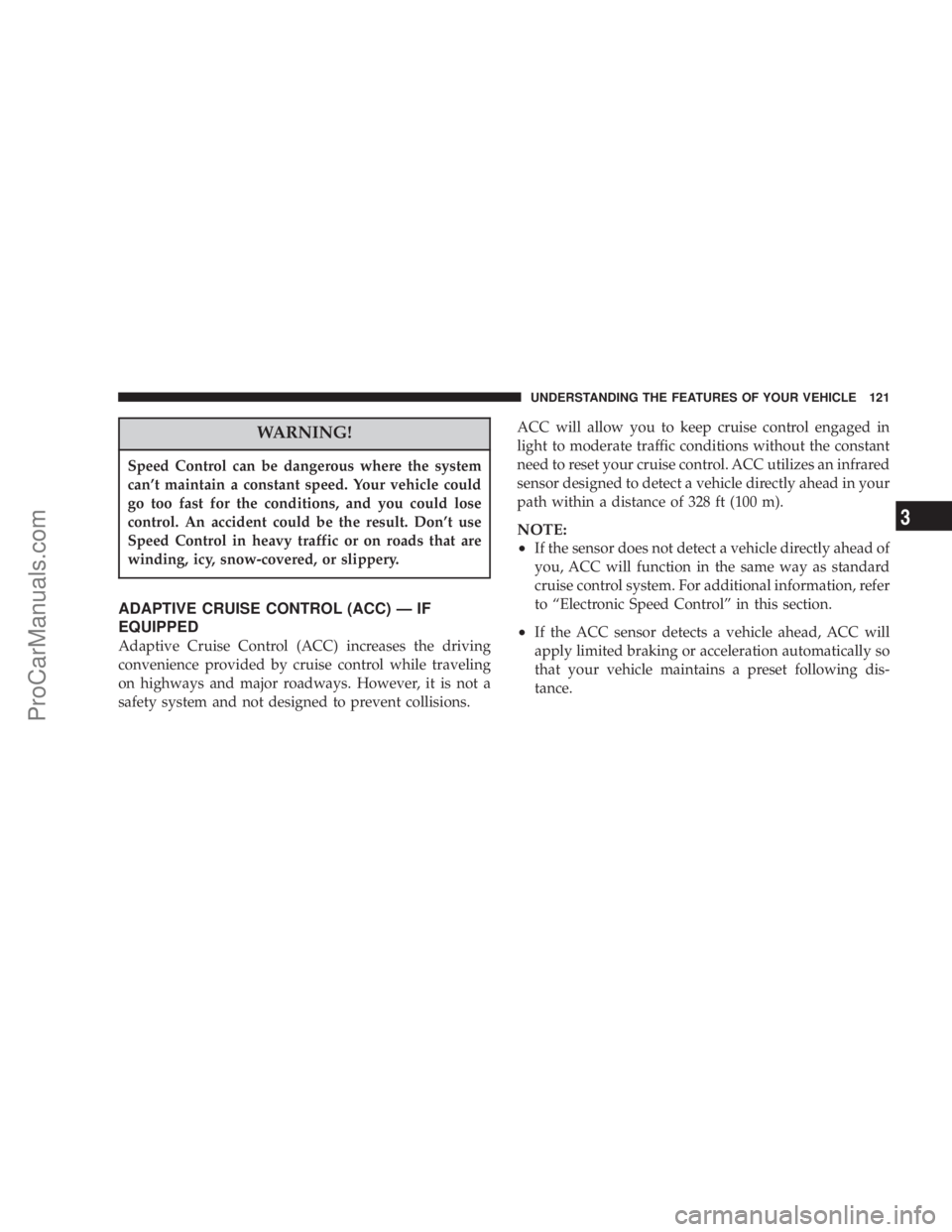
WARNING!
Speed Control can be dangerous where the system
can’t maintain a constant speed. Your vehicle could
go too fast for the conditions, and you could lose
control. An accident could be the result. Don’t use
Speed Control in heavy traffic or on roads that are
winding, icy, snow-covered, or slippery.
ADAPTIVE CRUISE CONTROL (ACC) — IF
EQUIPPED
Adaptive Cruise Control (ACC) increases the driving
convenience provided by cruise control while traveling
on highways and major roadways. However, it is not a
safety system and not designed to prevent collisions.ACC will allow you to keep cruise control engaged in
light to moderate traffic conditions without the constant
need to reset your cruise control. ACC utilizes an infrared
sensor designed to detect a vehicle directly ahead in your
path within a distance of 328 ft (100 m).
NOTE:
•
If the sensor does not detect a vehicle directly ahead of
you, ACC will function in the same way as standard
cruise control system. For additional information, refer
to “Electronic Speed Control” in this section.
•If the ACC sensor detects a vehicle ahead, ACC will
apply limited braking or acceleration automatically so
that your vehicle maintains a preset following dis-
tance.
UNDERSTANDING THE FEATURES OF YOUR VEHICLE 121
3
ProCarManuals.com
Page 122 of 432
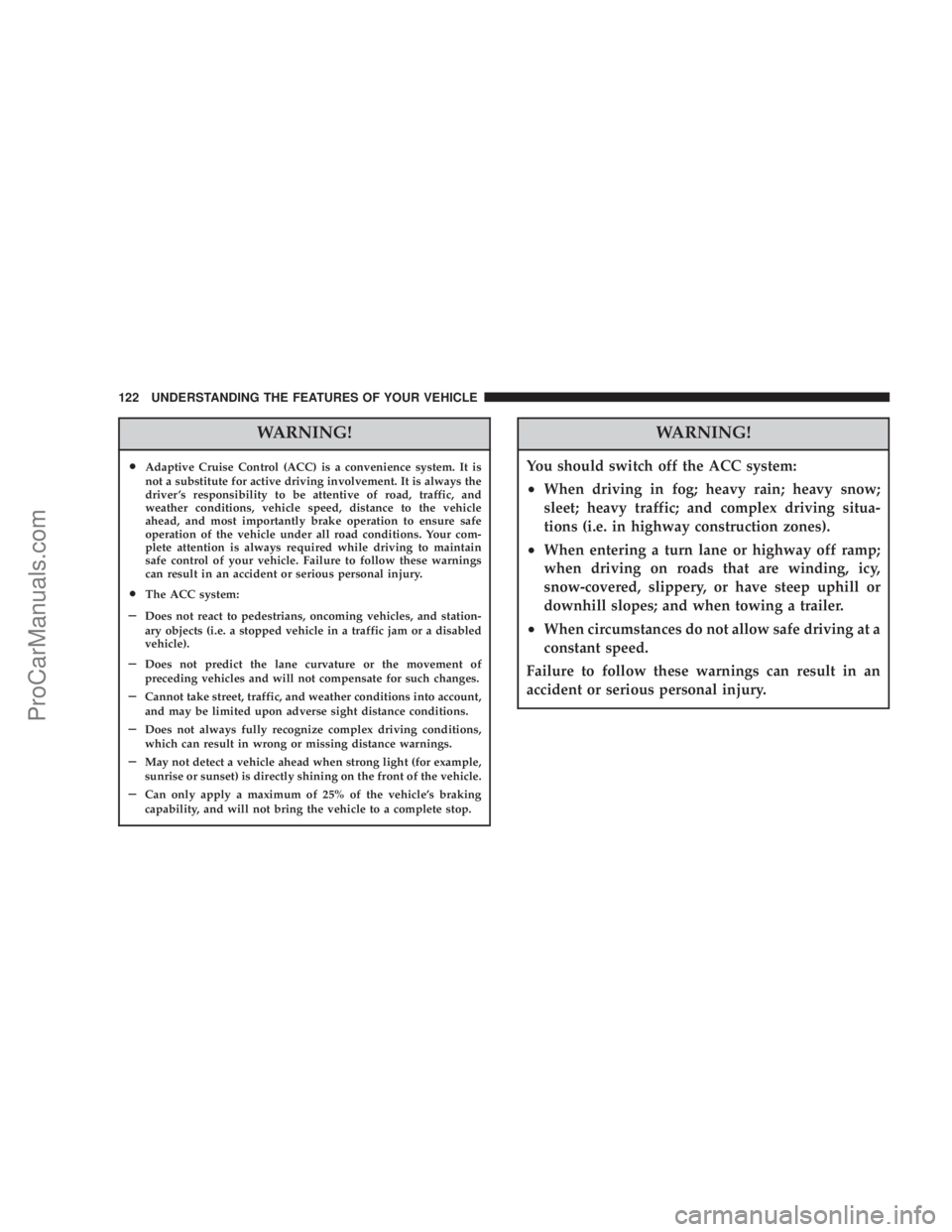
WARNING!
•Adaptive Cruise Control (ACC) is a convenience system. It is
not a substitute for active driving involvement. It is always the
driver ’s responsibility to be attentive of road, traffic, and
weather conditions, vehicle speed, distance to the vehicle
ahead, and most importantly brake operation to ensure safe
operation of the vehicle under all road conditions. Your com-
plete attention is always required while driving to maintain
safe control of your vehicle. Failure to follow these warnings
can result in an accident or serious personal injury.
•The ACC system:
�Does not react to pedestrians, oncoming vehicles, and station-
ary objects (i.e. a stopped vehicle in a traffic jam or a disabled
vehicle).
�Does not predict the lane curvature or the movement of
preceding vehicles and will not compensate for such changes.
�Cannot take street, traffic, and weather conditions into account,
and may be limited upon adverse sight distance conditions.
�Does not always fully recognize complex driving conditions,
which can result in wrong or missing distance warnings.
�May not detect a vehicle ahead when strong light (for example,
sunrise or sunset) is directly shining on the front of the vehicle.
�Can only apply a maximum of 25% of the vehicle’s braking
capability, and will not bring the vehicle to a complete stop.
WARNING!
You should switch off the ACC system:
•When driving in fog; heavy rain; heavy snow;
sleet; heavy traffic; and complex driving situa-
tions (i.e. in highway construction zones).
•When entering a turn lane or highway off ramp;
when driving on roads that are winding, icy,
snow-covered, slippery, or have steep uphill or
downhill slopes; and when towing a trailer.
•When circumstances do not allow safe driving at a
constant speed.
Failure to follow these warnings can result in an
accident or serious personal injury.
122 UNDERSTANDING THE FEATURES OF YOUR VEHICLE
ProCarManuals.com
Page 123 of 432
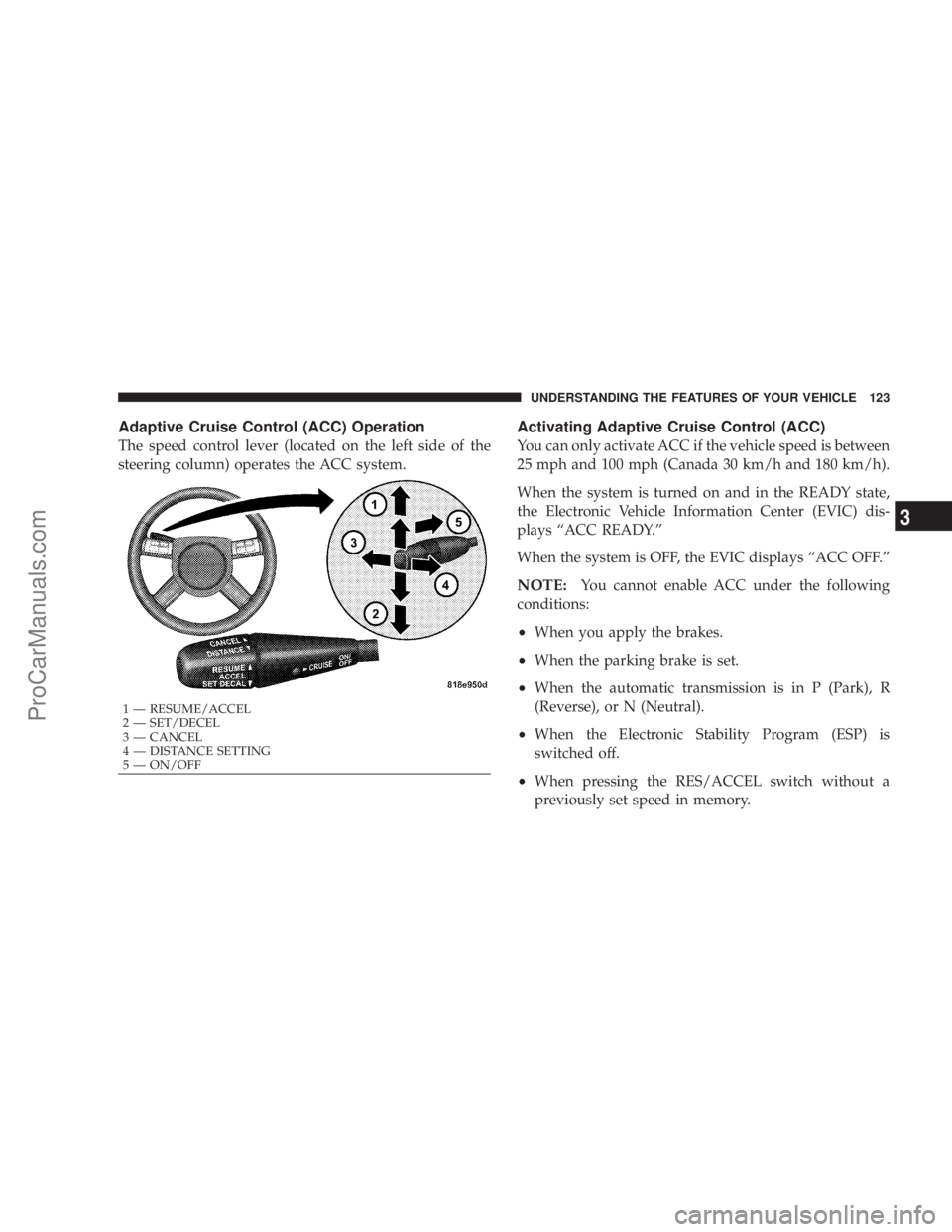
Adaptive Cruise Control (ACC) Operation
The speed control lever (located on the left side of the
steering column) operates the ACC system.
Activating Adaptive Cruise Control (ACC)
You can only activate ACC if the vehicle speed is between
25 mph and 100 mph (Canada 30 km/h and 180 km/h).
When the system is turned on and in the READY state,
the Electronic Vehicle Information Center (EVIC) dis-
plays “ACC READY.”
When the system is OFF, the EVIC displays “ACC OFF.”
NOTE:You cannot enable ACC under the following
conditions:
•When you apply the brakes.
•When the parking brake is set.
•When the automatic transmission is in P (Park), R
(Reverse), or N (Neutral).
•When the Electronic Stability Program (ESP) is
switched off.
•When pressing the RES/ACCEL switch without a
previously set speed in memory.
1 — RESUME/ACCEL
2 — SET/DECEL
3 — CANCEL
4 — DISTANCE SETTING
5 — ON/OFFUNDERSTANDING THE FEATURES OF YOUR VEHICLE 123
3
ProCarManuals.com
Page 124 of 432
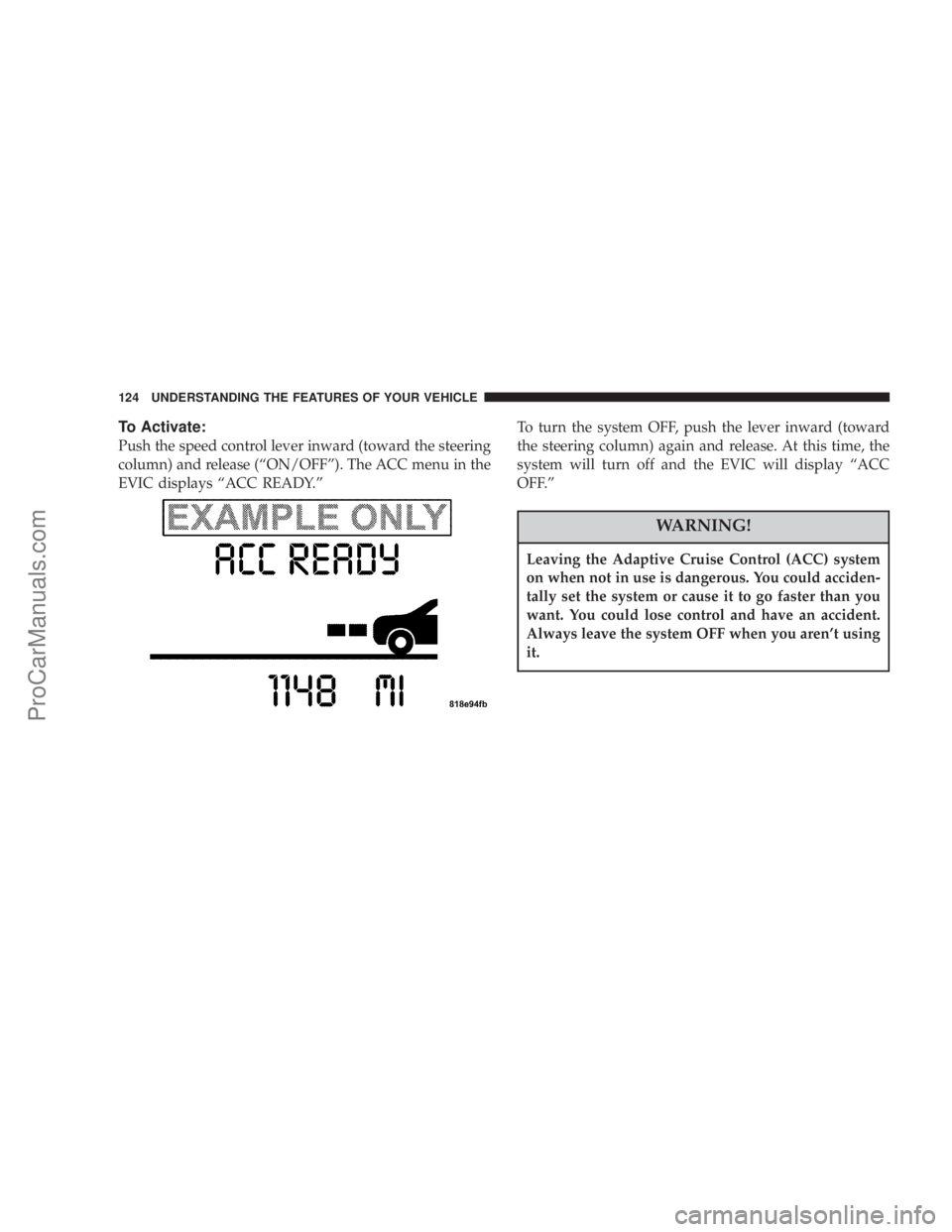
To Activate:
Push the speed control lever inward (toward the steering
column) and release (“ON/OFF”). The ACC menu in the
EVIC displays “ACC READY.”To turn the system OFF, push the lever inward (toward
the steering column) again and release. At this time, the
system will turn off and the EVIC will display “ACC
OFF.”
WARNING!
Leaving the Adaptive Cruise Control (ACC) system
on when not in use is dangerous. You could acciden-
tally set the system or cause it to go faster than you
want. You could lose control and have an accident.
Always leave the system OFF when you aren’t using
it.
124 UNDERSTANDING THE FEATURES OF YOUR VEHICLE
ProCarManuals.com
Page 125 of 432
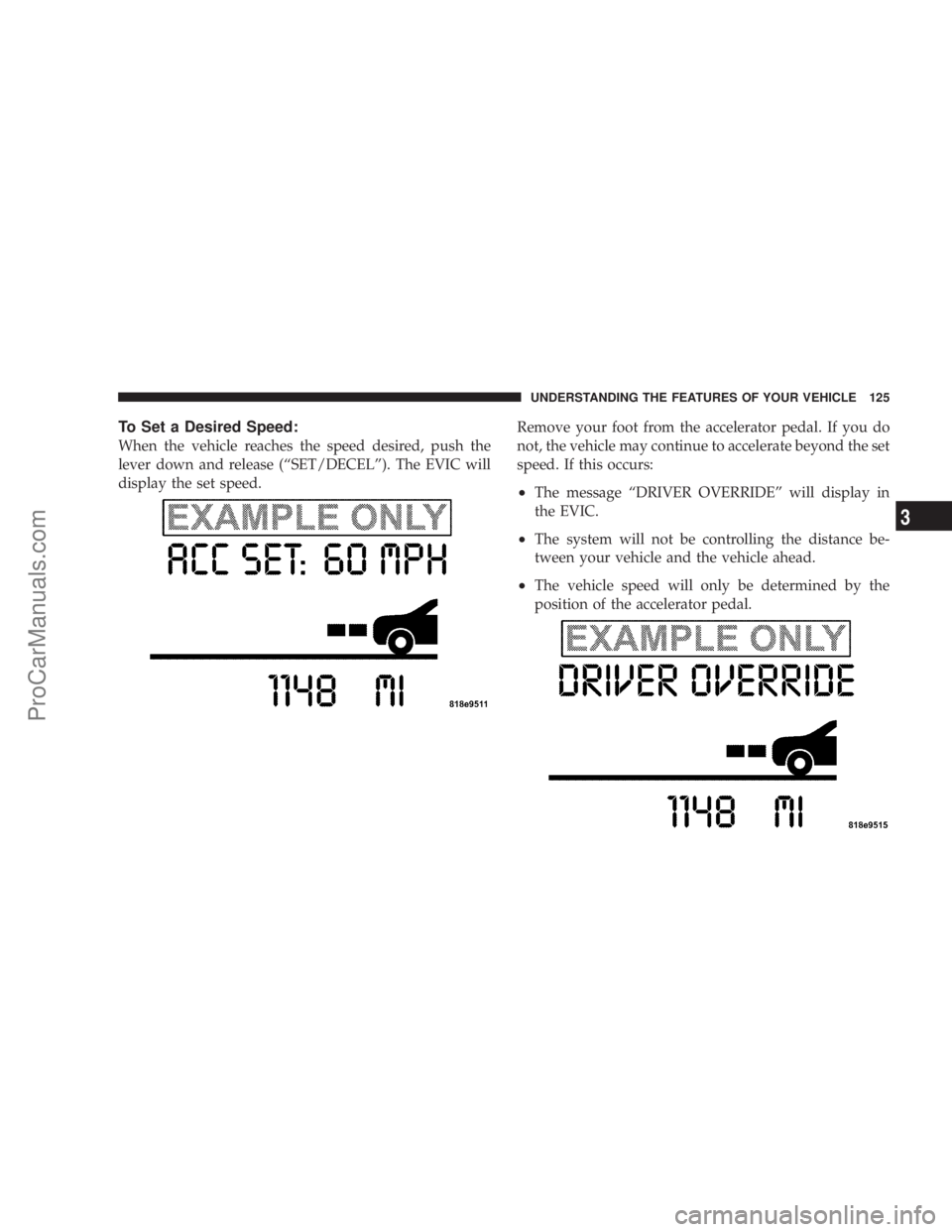
To Set a Desired Speed:
When the vehicle reaches the speed desired, push the
lever down and release (“SET/DECEL”). The EVIC will
display the set speed.Remove your foot from the accelerator pedal. If you do
not, the vehicle may continue to accelerate beyond the set
speed. If this occurs:
•The message “DRIVER OVERRIDE” will display in
the EVIC.
•The system will not be controlling the distance be-
tween your vehicle and the vehicle ahead.
•The vehicle speed will only be determined by the
position of the accelerator pedal.
UNDERSTANDING THE FEATURES OF YOUR VEHICLE 125
3
ProCarManuals.com
Page 126 of 432
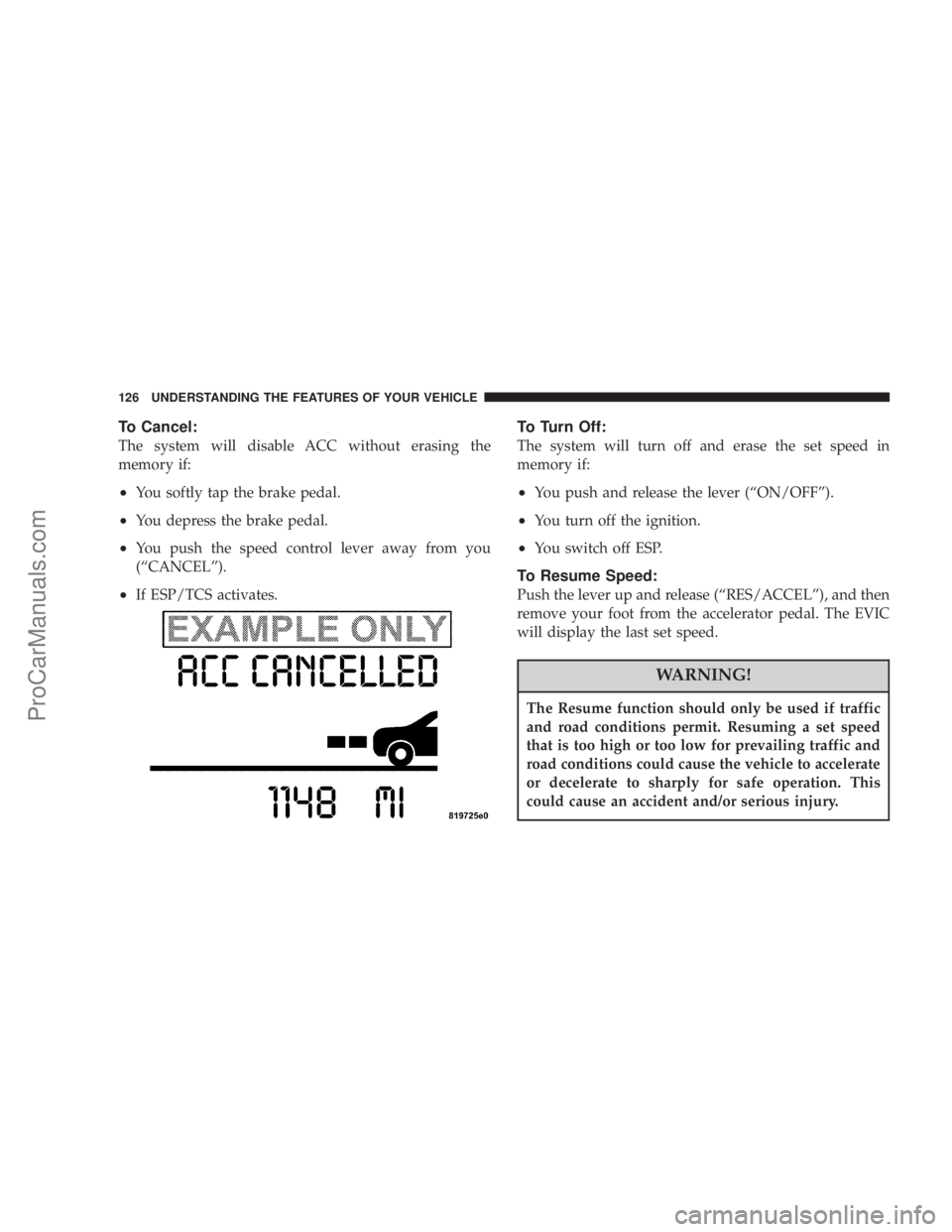
To Cancel:
The system will disable ACC without erasing the
memory if:
•You softly tap the brake pedal.
•You depress the brake pedal.
•You push the speed control lever away from you
(“CANCEL”).
•If ESP/TCS activates.
To Turn Off:
The system will turn off and erase the set speed in
memory if:
•You push and release the lever (“ON/OFF”).
•You turn off the ignition.
•You switch off ESP.
To Resume Speed:
Push the lever up and release (“RES/ACCEL”), and then
remove your foot from the accelerator pedal. The EVIC
will display the last set speed.
WARNING!
The Resume function should only be used if traffic
and road conditions permit. Resuming a set speed
that is too high or too low for prevailing traffic and
road conditions could cause the vehicle to accelerate
or decelerate to sharply for safe operation. This
could cause an accident and/or serious injury.
126 UNDERSTANDING THE FEATURES OF YOUR VEHICLE
ProCarManuals.com
Page 127 of 432

To Vary the Speed Setting:
While ACC is set, you can increase the set speed by lifting
and holding the lever up (“RES/ACCEL”). If the lever is
continually held, the set speed will continue to increase
in 5 mph (Canada 10 km/h) increments until the lever is
released. The increase in set speed is reflected in the EVIC
display.
Lifting the lever up and releasing once will result in a 1
mph (Canada 1 km/h) increase in set speed. Each sub-
sequent lift and release of the lever results in an increase
of 1 mph (Canada 1 km/h).
While ACC is set, the set speed can be decreased by
pushing the lever down and holding (“SET/DECEL”). If
the lever is continually held, the set speed will continue
to decrease in 5 mph (Canada 10 km/h) increments until
the lever is released. The decrease in set speed is reflected
in the EVIC display.Pushing the lever down and releasing once will result in
a 1 mph (Canada 1 km/h) decrease in set speed. Each
subsequent push and release of the lever results in a
decrease of 1 mph (Canada 1 km/h).
NOTE:
•
When you use the lever to decelerate, if the engine’s
braking power does not slow the vehicle sufficiently to
reach the set speed, the brake system will automati-
cally slow the vehicle.
•The ACC system maintains set speed when driving up
hill and down hill. However, a slight speed change on
moderate hills is normal. In addition, downshifting
may occur while climbing uphill or descending down-
hill. This is normal operation and necessary to main-
tain set speed.
UNDERSTANDING THE FEATURES OF YOUR VEHICLE 127
3
ProCarManuals.com
Page 128 of 432
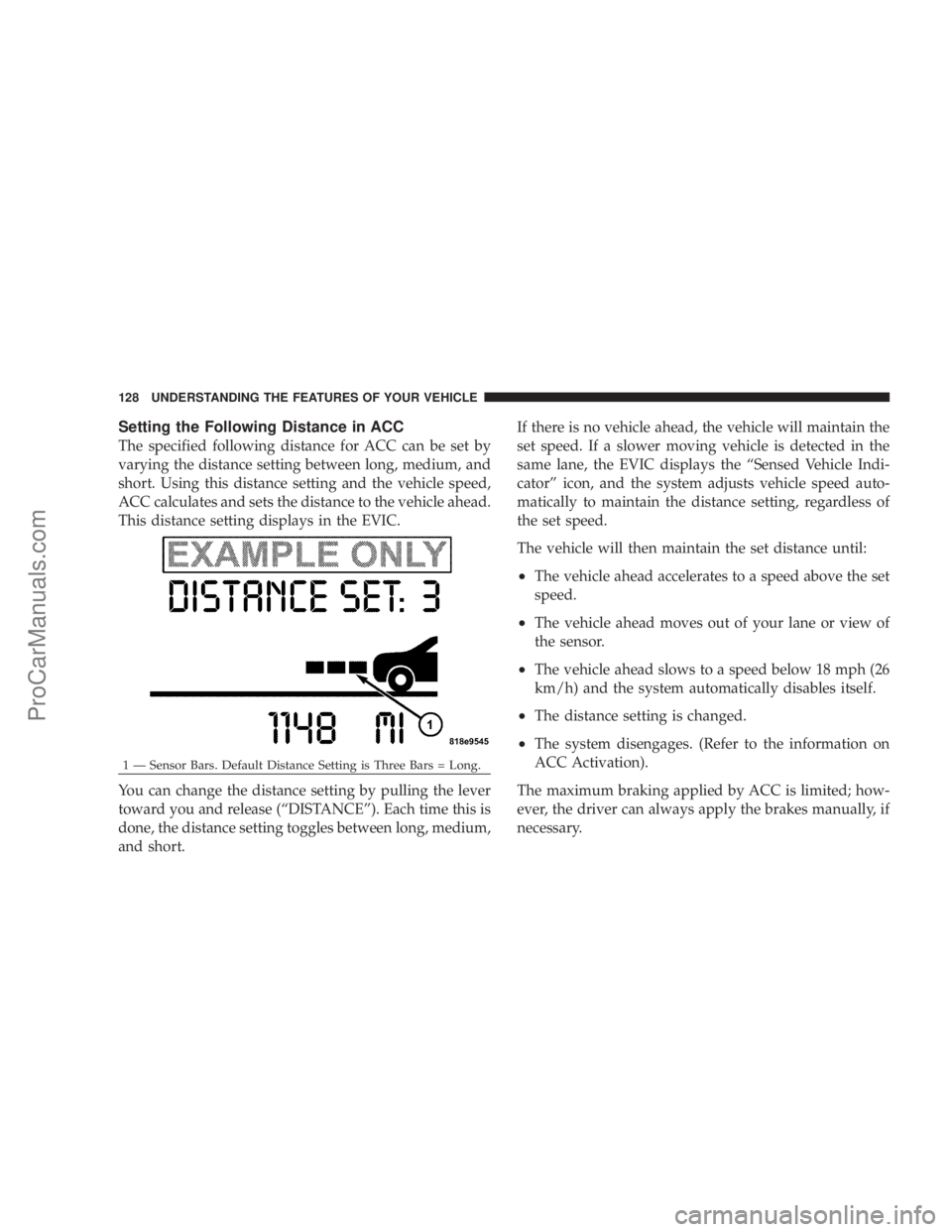
Setting the Following Distance in ACC
The specified following distance for ACC can be set by
varying the distance setting between long, medium, and
short. Using this distance setting and the vehicle speed,
ACC calculates and sets the distance to the vehicle ahead.
This distance setting displays in the EVIC.
You can change the distance setting by pulling the lever
toward you and release (“DISTANCE”). Each time this is
done, the distance setting toggles between long, medium,
and short.If there is no vehicle ahead, the vehicle will maintain the
set speed. If a slower moving vehicle is detected in the
same lane, the EVIC displays the “Sensed Vehicle Indi-
cator” icon, and the system adjusts vehicle speed auto-
matically to maintain the distance setting, regardless of
the set speed.
The vehicle will then maintain the set distance until:
•The vehicle ahead accelerates to a speed above the set
speed.
•The vehicle ahead moves out of your lane or view of
the sensor.
•The vehicle ahead slows to a speed below 18 mph (26
km/h) and the system automatically disables itself.
•The distance setting is changed.
•The system disengages. (Refer to the information on
ACC Activation).
The maximum braking applied by ACC is limited; how-
ever, the driver can always apply the brakes manually, if
necessary.
1 — Sensor Bars. Default Distance Setting is Three Bars = Long. 128 UNDERSTANDING THE FEATURES OF YOUR VEHICLE
ProCarManuals.com
Page 129 of 432

A Proximity Warning will alert the driver if ACC predicts
that its maximum braking level is not sufficient to
maintain the set distance. If this occurs, a visual alert
(“ATTENTION”) will flash in the EVIC and a chime will
sound while ACC continues to apply its maximum
braking capacity. When this occurs, you should immedi-
ately apply the brakes as needed to maintain a safe
distance from the vehicle ahead.Adaptive Cruise Control (ACC) Menu
The EVIC displays the current ACC system settings. The
EVIC is located in the upper part of the instrument
cluster between the speedometer and the tachometer. The
information it displays depends on ACC system status.
Press the Menu button (located on the steering
wheel) repeatedly until one of the following
displays in the EVIC:
Menu
Button
UNDERSTANDING THE FEATURES OF YOUR VEHICLE 129
3
ProCarManuals.com
Page 130 of 432

ACC OFF
�
When ACC is deactivated, the display will read “ACC
OFF.”
ACC READY
�
When ACC is activated, the display will read “ACC
READY.”
130 UNDERSTANDING THE FEATURES OF YOUR VEHICLE
ProCarManuals.com